
|
|
Issue Number 20 • Tuesday, July 17, 2018 |
Campus ChampionDaniel Sidebottom, director of Administrative Computing Services, is honored by his recent SUNY Technology Conference Lifetime Achievement Award. His 40-year career with SUNY, nearly 20 of those at SUNY Cortland, offers evidence of his outstanding contributions that have helped advance SUNY technology. His EDUCAUSE article, “Blending Nature and Technology,” discussed network technology at Raquette Lake. In 2003, Dan’s team implemented the College’s first full voice over IP network infrastructure, earning SUNY Cortland the prestigious EDUCAUSE Networking Award. As a governor’s taskforce member, he helped launch the SUNY NY-Alert emergency notification system, and through Dan’s involvement on the president’s taskforce, SUNY Cortland led with a campus-wide emergency alert speaker system. Thursday, Aug. 23President’s Opening Address and Faculty Meetings: Corey Union Function Room, 8 a.m. New Student Move-In Day: Residence halls open to new students attending orientation and approved early arrivals, between 1-4 p.m. Friday, Aug. 24New Student Move-In Day: Residence halls open to new students who attended orientation, between 9 a.m.-4 p.m. Saturday, Aug. 25Student Move-In Day: Residence halls open to new and returning students, between 9 a.m.-4 p.m. Opening Week Event: Green Dot Speaker, Corey Union Function Room, 1 p.m. and 3 p.m. Sunday, Aug. 26Student Move-In Day: Residence halls open to new and returning students, between 10 a.m.-4 p.m. Academic Convocation: Park Center Alumni Arena, 4 p.m. Monday, Aug. 27Fall Semester Classes Begin Tuesday, Aug. 28Open Mic Night: Corey Union Function Room, 7 to 9 p.m. Wednesday, Aug. 29Student Employment and Volunteer Fair: Sponsored by Career Services, Corey Union Function Room, 3-5 p.m. Friday, Aug. 31Study Abroad and International Student Welcome Party: Corey Union steps (Function Room), noon to 1:30 p.m. Friday, Aug. 31Cortland Nites Event: Corey Union Function Room, 7 to 11 p.m. Sunday, Sept. 2Welcome Week Event: Outdoor Movie, Moffett Center lawn, 8 to 10:30 p.m. Monday, Sept. 3Labor Day: No classes, offices are closed Student Club Fair: Corey Union steps, noon to 3 p.m. This is the last issue of The Bulletin for the summer. The next issue of The Bulletin will be published on Tuesday, Aug. 28. Fall 2018 Bulletin Publication Dates Bulletin #1 Tuesday, Aug. 28 Bulletin #2 Tuesday, Sept. 11 Bulletin #3 Tuesday, Sept. 25 Bulletin #4 Tuesday, Oct. 9 Bulletin #5 Tuesday, Oct. 23 Bulletin #6 Tuesday, Nov. 6 Bulletin #7 Tuesday, Nov. 20 Bulletin #8 Tuesday, Dec. 4 |
New College Institute to Focus on Drone Technology07/13/2018The SUNY Cortland Institute of Applied Geospatial and Drone Technology won part of a $10 million Downtown Revitalization Initiative award presented to the City of Cortland on Thursday. The institute, which will be led by members of the College’s Geography Department, will serve as a resource for entrepreneurs and startup companies as the City of Cortland strives to become a hub for geographic information systems (GIS), technology used for digital map-making, and drones. Funding will be used to renovate existing space on Main Street for meeting and office spaces as well as the purchase of equipment. An outdoor drone testing facility is also part of the project plan. SUNY Cortland already has made inroads with private and public entities and academic institutions in exploring GIS and drone technology. In the spring of 2017, the College joined the NUAIR Alliance, a not-for-profit coalition that operates drone test ranges. The institute will continue those efforts, focusing on linking SUNY Cortland faculty and students with members of the business community in the City of Cortland. “Right off the bat, we’re hoping to really find out what these community organizations need and want more than what we’re already giving them,” said Wendy Miller, associate professor and chair of the College’s Geography Department. “We want to introduce them to drone technology.” “It’s a wonderful opportunity for a collaboration between SUNY and other entities,” said Brian Tobin ’94, mayor of the City of Cortland. “We’re excited to have it right downtown because it keeps business and people in an area where they can continue to rub elbows with each other and continue to see our community grow.” The location of the institute and the drone testing facility is yet to be determined. In most cases, those who pilot drones in New York state need to be licensed and registered. The drone testing facility will be an enclosed space that will allow unlicensed pilots the opportunity to get hands-on drone experience. This is of particular interest to Miller, who hopes to expand the institute’s outreach to include local schoolchildren. Academically, the institute won’t be limited just to faculty and students in the Geography Department. For example, geology students may use drones to study rock formations and biology students could use the technology to research plant growth. College offices such as Facilities Operations and Services may use infrared cameras attached to drones to manage the energy efficiency of campus buildings. “The technology is fantastic but it’s going to be about trying to figure out what we can get from the data,” Miller said. “What can we learn that’s new that we wouldn’t have any other way of finding out? Whether it’s an infrared camera looking at the roofs or monitoring farm fields for water usage or looking at forests and vegetation or even the police and fire departments, the applications are never-ending.” “Since we have such a strong academic program here that has such a strong practical application, the opportunity to take classroom learning and make it practical and do to so in a real-world environment will be potentially transformational,” said Tobin. “Doing it right here in Cortland is very exciting.” The institute will receive $100,000 in funding. More information on the Downtown Revitalization Project is available at governor.ny.gov. Summer Research Fellow Uncovering Lime Hollow’s History07/17/2018The Lime Hollow Nature Center located just a few miles from the SUNY Cortland campus features 430 acres of woods and wetlands. Local residents frequent it as a respite, to hike the trails and connect with nature. That area, however, hasn’t always been so serene. It was home to a bustling lumber mill and many farmsteads over the past few centuries. This summer, one busy SUNY Cortland student is trying to find out exactly what took place where on the grounds. Senior geographic information systems major Devyn Tremblay is one of 10 SUNY Cortland students who received a 2018 undergraduate summer research fellowship. He’s working with History Department faculty mentor Scott Moranda in digitally mapping and uncovering the history of Lime Hollow. Tremblay, from Helmetta, N.J., is minoring in computer applications and has a concentration in advanced geospatial applications. During his sophomore year, he worked with Scott Anderson, professor in the Geography Department, to chart a small section of the nature center. “We came out here and mapped a few of the old ponds and dikes and dams for the lumber mill,” Tremblay said. “From there, the idea expanded. Now we’re going to do the entire property.” The Lime Hollow Nature Center is a private, 501(c)3 not-for-profit that is celebrating its 25th anniversary in 2018. It offers year-round recreation opportunities as well as summer camps for children and a variety of educational events. 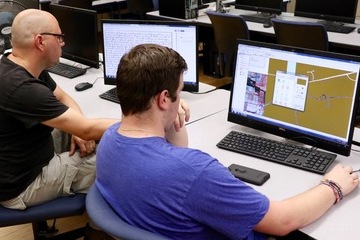
Moranda, associate professor of history, has helped Tremblay sift through approximately 200 years of property deeds for the area from the Cortland County database. Tremblay’s ultimate goal is to create a video using GIS software that shows the changing ownership and usage of the land in each parcel of the 430-acre nature center. The scope of this research is much more intense than the work Tremblay did two years ago. “This is entirely different,” he said. “That was one tiny little piece in a 500-piece puzzle. And that’s what it is, it’s a puzzle. We’ll sit there in the lab trying to figure out one piece of it for hours.” First, Tremblay and Moranda will walk through Lime Hollow searching for stone walls, tree walls or surveyors’ corners that may indicate an old property line. Tremblay will mark the coordinates on his Trimble GPS unit and then he will search through the archived deeds for a match. It isn’t always that easy. Some of the deeds lack coordinates or accurate measurements. Others make reference to natural landmarks that are long since gone. Tremblay was particularly frustrated by one record that indicated a property line began at “an elm tree in the middle of the highway.” That didn’t serve as much of a clue in 2018. Not only is Tremblay mapping what pieces of land belonged to certain people at a given time, he and Moranda are also consulting cultural censuses from the 19th century that shed light on the types of crops farmers were growing. The ecology of the area is ever-changing. For example, about 100 years ago, very little of the Lime Hollow area was forested. “Maybe there’s a young maple forest there now, but we will be able to say that this area was pasture in 1880 or that was a farm that grew corn,” Moranda said. The economic history of the people who lived around Lime Hollow is depicted in the data as well. Certain time periods, say 1929-30, show a volatile shift in land ownership, as would be expected at the breakout of the Great Depression. Other periods have left Tremblay scrambling to find more hints in the County’s historical archives. 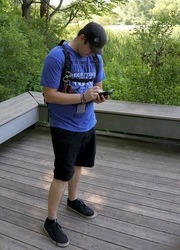
“There have been a lot of interesting transactions between properties that you wouldn’t expect,” Tremblay said. “There is a single creamery and a wood mill where you can trace back the property to the early 1850s. At one point it was owned by eight different people in five years. You never expect something like that. The puzzle changes.” Tremblay plans to present his research at the New York State Geospatial Summit, which will be held in Skaneateles, N.Y. in September. He’ll also share his findings at SUNY Cortland’s annual “Transformations: A Student Research and Creativity Conference” in the spring of 2019. Moranda, whose specialties are German history and environmental history, has a long-term goal of creating a mobile application and a website to host digital mapping projects such as Tremblay’s. Since their findings have such a wide range of academic interest, from economics to biology and everything in between, this data may be useful to others for decades to come. “Once Devyn creates this map, this ends up being a research tool for other scholars,” Moranda said. “If you’re interested in economic history and land ownership, they could use this as a tool to trace that. Or if they’re biologists and they want to know the historic ecology, this could be helpful.” The undergraduate summer research fellowships were created in 2007 to offer students and faculty mentors to engage in eight weeks of full-time scholarly activity during the summer. The fellowships are student-designed and include a modest stipend and up to eight weeks of on-campus housing. This year’s 10 summer research fellows are studying a range of subjects from biological sciences to psychology to political science. Tremblay has thrived this summer, racing back and forth between mapping points at Lime Hollow and inputting the data on a computer in the Geography Department lab in Old Main. “One skill he’s learning is patience,” laughed Moranda. “But he’s also learning puzzle-solving.” “And puzzle making,” added Tremblay. This experience has helped solidify Tremblay’s decision to pursue his academic passion in graduate school. “A master’s degree will allow me to continue historical GIS and work within archeological dig sites as well as other forms of ancient or even more modern, such as 19th or 20th century, historical geography,” he said. “It’s tedious but it’s fun.” Capture the MomentHundreds of returning alumni and friends celebrated the kickoff of the SUNY Cortland Sesquicentennial at Alumni Reunion 2018 as they enjoyed class get-togethers, parties and other activities both on and off campus from July 12-15. On Friday, Tom Dooling ’74, far left, looked on as Corey Lebow ’76 and Amy Dahlman ’78, M ’93, reconnected outside of the Lynne Parks ’68 SUNY Cortland Alumni House. Dahlman is a senior counselor for the Educational Opportunity Program at SUNY Cortland. Photos from Reunion 2018 will be posted as they are submitted. In Other NewsCamping Meets Planning at Raquette LakeRhonda Jacobs Pitoniak ’01, M ’16 has a colorful name for the way maintenance had been approached at the William H. Parks Family Center for Environmental and Outdoor Education before the creation of a five-year, $1.25 million repair and upkeep plan. “We’re trying to move away from disaster du jour,” joked Pitoniak who, as camp center director, has personally taken a wrench to more than her fair share of drippy sinks and leaky toilets at the College’s two historic camps. “We want to get to a point where we are looking at preventive maintenance rather than repairing things when they break: when they are beginning to pass their prime,” she said. Starting in the 2016-17 academic year, the College implemented a five-year rolling plan to devote $250,000 per year to restoring or upgrading the College’s two Adirondack camps, sited at different locations along the wooded shores of Raquette Lake. Because of this approach, the College this year did routine building maintenance and made extensive repairs to the Camp’s main dock, heading off deterioration that would have eventually required replacement. During the 2018-19 academic year, the College will upgrade the facility’s water treatment plant and electrify the work shed at Antlers, the more accessible of the two camps. The current plan runs through 2022. 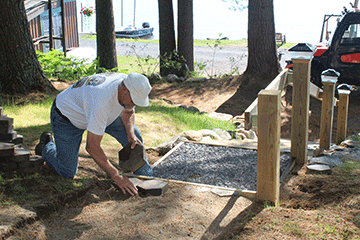
Annual support for the improvements and renovations includes $100,000 in New York state funding earmarked for critical maintenance, $100,000 from the campus-wide budget of the Facilities Planning, Design and Construction Office (FPDC), and $50,000 in gifts to the Raquette Lake Facilities account managed by the Cortland College Foundation. “One of the main reasons the Facilities Planning Design and Construction office is doing it this way is because that’s the way budgeting is done for the campus,” Pitoniak said. “It’s the first time Parks Family Outdoor Center has been included in five consecutive years that I’m aware of.” Money previously was doled out for one project at a time, for example when a camp building needed a new roof or the Raquette Lake campus required a new carpentry shop, she said. The more remote camp, Camp Huntington — once called Camp Pine Knot — was built in the 1870s by William West Durant, considered to be the grandfather of the unique Adirondack Great Camp style of architecture on this very site. Acquired by SUNY Cortland in 1948, the camp in 2004 was named a National Historic Landmark. Camp Huntington features more than a dozen individual buildings, most of them constructed before the turn of the 20th century in the original rustic Adirondack great camp style. Some were built to replace structures destroyed in 1983 by a fire. The College’s second camp on the lake, Antlers at William H. Parks Family Center for Environmental and Outdoor Education, is roughly as old as Camp Huntington but much less remote and inaccessible. During the next five year plan, Camp Huntington will undergo extensive improvements based on a bark and log condition survey the College commissioned from Argus Architecture & Preservation, P.C. from Troy, N.Y. Some areas will be graded for better drainage. Branches or trees that overhang structures and threaten to damage them will be removed, reducing the shade that hastens buildings’ decay. Damaged or rotting sections of log siding will be replaced. Problems with maintaining some buildings’ structural integrity will be addressed by replacing footings, stabilizing the soil near the buildings and repairing posts. Gutters will be added to keep rain water from running down the sides of structures. Chimneys will be cleaned and re-pointed. Trees will be cleared away from selected buildings and land surrounding them will be regraded for improved air flow to keep the foundations and exterior walls drier. “Some of it will be easy for us to take care of and some will involve specialized contractors, historic renovations specialists, to come in and do the work,” Pitoniak said. 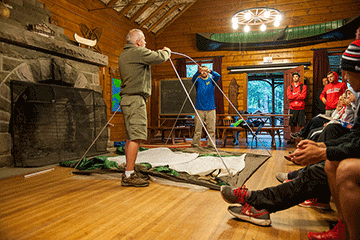
Camp Huntington’s main dock repair work began in November but was halted due to weather conditions. Work resumed this June. One of the most important projects is next year’s upgrade of the water treatment plant. “At times our capacity — the number of guests we can house — taxes the current water systems recovery time,” Pitoniak said of the system that draws and treats lake water and stores it in a tank on stilts. The biggest Antlers projects for this year is more modest. Antlers is going to be getting electricity for its shed shop, where Robert Brewster, the part-time caretaker hired last year so the College can stay on top of maintenance, will be able to run machinery, Pitoniak said. “There’s a shed behind the actual lodge where he does carpentry and repairs,” she said. “He can build new screens, repair furniture, repair a door or build new frames.” A new propane generator will be installed beside the shed. One addition to this project under consideration is an electric car charging station. “The generator will run as backup when the power goes out so we will still have power for guests, as well as be able to run the water system in the Main Lodge,” Pitoniak said. “The projects are linked because they both include electricity. Both will involve digging trenches and running lines for electricity.” The Main Lodge currently serves as Antlers’ longer season accommodations. Visitors to Camp Huntington in coming years can expect to see the Swiss Chalet’s dilapidated railings replaced and the his and hers bath facility completely remodeled because the vintage 1984 replacement parts are no longer available. At Antlers, the Main Lodge will get a facelift, too, with new siding and insulation. There’s much more upkeep to having the two camps than the considerable upkeep that generous alumni and friends can accomplish during the annual volunteer work weekends, held this year from May 4-6 at Camp Huntington and from May 11-13 at Antlers. At Antlers, alumni recently removed an old gas pump and installed proper steps leading up to the nearest cabin, Cedars. “The need for fundraising to support the camps and the alumni volunteer work camps to keep them up will continue as before,” Pitoniak said. “It’s a malleable plan so if something else were to come up that we think is more important, we would handle that.” Columns Summer 2018 Edition is Available OnlineFor 150 years, SUNY Cortland has been all in educating tomorrow’s leaders. That theme — all in — is how the College reflects on a century and a half of history in the Summer 2018 edition of Columns, SUNY Cortland’s alumni magazine. The issue is available to read online. Highlights of this issue include:
The issue also features profiles on the 2018 Distinguished Alumni honorees, as well as the Distinguished Young Alumni, honorary alumna, outstanding alumni volunteer and the inaugural distinguished educator awards. Of course, Columns has the latest Class Notes of personal and professional updates of Red Dragons from around the world. The center spread of this edition includes a timeline of 150 years of SUNY Cortland history. To view a thorough look at the College’s past, visit the SUNY Cortland Sesquicentennial page to see a digital timeline curated by faculty and students from the History Department. Sesquicentennial celebrations begin at Alumni Reunion 2018 and will continue into 2019. Alumni are encouraged to join in on social media using the hashtag #Cortland150. Readers may navigate the online version of Columns in a variety of ways. The page view simulates reading the hard-copy version of the magazine and the reading view offers a more mobile-friendly experience. Toggle between the two options using the button in the top right corner of the screen. To go all in and share your news, please visit RedDragonNetwork.org. College Introduces New Certificate for Teacher LeadersSUNY Cortland has introduced a new certificate program for high-achieving teachers looking to make leadership skills stand out on their résumés. The College’s Advanced Certificate in Teacher Leadership can benefit educators who are interested in becoming department chairs, grade-level coordinators, lead teachers or academic coaches. The credential entails four introductory courses that also count towards a Certificate of Advanced Study (C.A.S.) if students wish to continue in SUNY Cortland’s Educational Leadership Program. “There are so many new opportunities for teachers to work on special assignment within their school districts,” said Chris Manaseri, assistant professor and coordinator of the College’s Educational Leadership Program. “These opportunities don’t necessarily require a full administrative degree, but teachers may want some additional training. “This certificate is the perfect model for that.” Prospective students must hold a master’s degree and have at least three years of teaching experience. The 12-credit certificate will be available starting in Fall 2018 and current students may apply coursework retroactively. Topics to be covered include curricular leadership, supervision, organizational change and special programs. All four courses are taught in a hybrid format that involves online learning and five campus visits per semester. “These are skills that teacher leaders need even if they don’t want to become licensed superintendents or building principals or business officials,” Manaseri said. The certificate also serves as a formalized introduction to SUNY Cortland’s three C.A.S. programs: School Building Leader (SBL), School District Leader (SDL) and School District Business Leader (SDBL). The program allows teachers to make their leadership skills stand out among their peers and test the waters of an administrative degree. “We see this as a stackable credential,” said Manaseri, a former school principal and district superintendent. “Start the program with building effective classrooms, then move into topics such as school law and finance, then take principalship and district leadership courses where you’re looking at things from a managerial level.” For more information on SUNY Cortland’s Educational Leadership Program, visit its webpage or contact Manaseri through the College’s Foundations and Social Advocacy Department at 607-753-2447. Red Dragon Strong: Brian Tobin ’94Brian Tobin ’94 remembers what drew him to SUNY Cortland as a teenager. He was a star athlete from Dutchess County, so a spot on the men’s swimming and diving team was one major factor. Tobin would go on to capture 11 individual SUNYAC titles and was an eight-time All-American as a Red Dragon. He’s most proud of helping lead Cortland to the 1992-93 SUNYAC team championship. Yet it was the atmosphere he felt on a campus tour that made his decision easy. “I do remember walking through campus and people would look at you and smile and say hello,” Tobin said. “So many people were wearing Cortland apparel, it was obvious that there was a strong sense of community and pride in that community. When people are proud of where they are and what they represent, that’s exciting.” That was the same feeling that made Tobin come back to SUNY Cortland and decide to run for public office years later. After he graduated, Tobin earned a master’s degree in recreation management from the University of Wisconsin-La Crosse. He went on to coach the swimming and diving teams at SUNY Potsdam for five seasons and then was a volunteer assistant coach and a physical education lecturer at North Carolina State University. When the SUNY Cortland swimming coach position opened up in 2002, Tobin returned to take his dream job and to build on that Red Dragon community spirit he felt as a student. 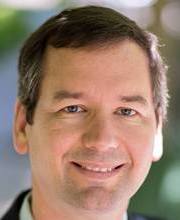
He took that role to heart, first serving as a volunteer on the board of the American Red Cross of Cortland County. As someone who had been a SUNY Cortland student, worked directly with students and lived in the community, Tobin was encouraged to run for office to help forge connections between student renters and city homeowners. He was elected to Cortland City Council in 2008. “Being a new homeowner and being concerned about home ownership in general, I thought I was uniquely positioned to potentially have an impact and work on some of the issues that student renters were facing as well,” Tobin said. Elected mayor in 2011, Tobin has continued to strengthen the connections between the College and the city. “There was a problem and I thought I could help fix it and I ran for office with the intention of helping to bridge what was a little bit of a divide between SUNY Cortland students and the community,” Tobin said. “I wouldn’t say we’ve completely built the bridge, we’re still working on some things, but I think that things are much better than they were 10 years ago.” 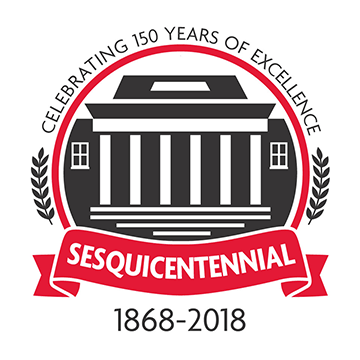
Thanks in large part to his leadership, the city recently received a $10 million Downtown Revitalization Initiative award from New York state that will benefit city residents, business and SUNY Cortland. Tobin continues to coach swimming and diving at SUNY Cortland. He’ll begin his 17th season at the helm of the Red Dragons’ program this fall. Whether he’s on the pool deck or at city hall, Tobin has the same goals. He wants the Cortland community, both on campus and off, to be that same welcoming and proud place he recalled from his initial visit. “Cortland feels like home,” he said. “Cortland is home.” Throughout SUNY Cortland’s Sesquicentennial, the College is profiling alumni who have made significant and positive impacts on the local community. For more information on 150 years of SUNY Cortland history, visit cortland.edu/150. Graduate Students Raising Aphasia AwarenessMore than 2 million Americans live with aphasia, a communication disorder that impairs the ability to process language. Head trauma, stroke and dementia are some but not all causes of this type of brain injury. People with aphasia may have problems saying words the right way, thinking of the words to say or understanding conversations and written instructions. Approximately 80 percent of the population is unaware of the condition. Graduate students in Eileen Gilroy’s Communication Disorders in Adults summer course are getting out into the Cortland community to help raise the quality of life for local people with aphasia as well as raising awareness. A new partnership between the College and Cortland Regional Medical Center benefits SUNY Cortland students and medical professionals in the field. Morgan Cerio ’17 and Margaret Woodworth ’17, both from Elmira, N.Y., are pursuing a master’s in communication sciences and disorders. As part of their coursework this semester, they developed visual menus to be used in a pilot program at Cortland Regional. These menus will allow patients who have trouble communicating verbally to point to photos of the meal they would like to receive. “This is where they live, 24/7, so they should have the power to be able to choose for themselves what they want to eat,” Cerio said. “That is so hard for people with aphasia. Sometimes words get confusing for them. We’ve made it more accessible for the nurses to use, too.” 
Patients with aphasia may be unable to understand questions or may use the wrong words when they try to speak. For example, when a patient is asked what they would like to drink with a meal, they may say “coffee” when they intended to say “water.” The visual menu will help medical professionals make sure that their patients are getting what they want. “To get the wrong thing or to not be able to say, ‘I want salt and pepper on this,’ it’s so frustrating,” Woodworth said. “It gives them their quality of life back.” On July 20, Marisa Spagnolo ’17 of Pepperell, Mass. and Angelique Jean-Charles ’16 of Elmont, N.Y. will deliver a presentation to Cortland Regional staff on how emergency responders can best interact with people with aphasia. Spagnolo and Jean-Charles will share the story of a person with aphasia who was driving when pulled over by a police officer. Symptoms of aphasia may make it appear as if they are intoxicated to those who are unfamiliar with the condition. Paramedics and law enforcement officers who work patiently with those with aphasia can in turn better serve the medical professionals who will treat them. Students like Spagnolo and Jean-Charles are glad to share their expertise with others. “It’s nice to show other professionals that we’re not just people who work in schools and work with kids on fixing their sounds,” Jean-Charles said. “We have a very profound background in neurology, not as much as neurologists, obviously, but we know the systems involved. It’s really interesting to see the medical aspect of it and how we can benefit others.” First-hand experience working with medical professionals on aphasia issues is a vital learning tool for SUNY Cortland students. "It takes a lot of patience on the part of the nurses and doctors to have those conversations," said Dana Hogan, a Cortland Regional speech-language pathologist, MS, CCC-SLP. "The students are learning how to communicate with them, which they can’t teach you in school. The practical knowledge of their background in communication sciences and disorders is put into the real world." A number of students, including Lora Ottaviano ’17 of Smithtown, N.Y., Sarah Ellis ’17 of Whitney Point, N.Y. and Janelle Zachary ’17 of Cortland, N.Y., spoke with local residents at the Cortland County Area Agency on Aging’s annual senior enrichment day in June. Not only did they help raise awareness about aphasia, they also sought insight from local seniors on developing strategies for helping those living with the condition. “It’s all about interprofessional collaboration,” Ottaviano said. “That’s something that’s heavily emphasized here in our program.” Gilroy, a lecturer in the Communication Disorders and Sciences Department, has been working to inform the local community about aphasia since 2015. Cortland Mayor Brian Tobin ’94 has proclaimed June as National Aphasia Awareness Month. Gilroy’s students have also given presentations at Walden Place, an assisted living and memory care facility in Cortland, as well as Access to Independence of Cortland County. The students are tasked with writing a reflection paper as part of the course, describing who they’ve interacted with and where they’ve visited. Gilroy said her students have been excited to add these hands-on experiences to their classroom instruction, as they feel like they’ve already made a difference. “They feel like they’ve helped people who have communication problems who they don’t even know yet because they’re educating other people about it,” Gilroy said. “They’re spreading the word that might help people in our community who are having communication challenges.” SUNY Cortland Salutes Class of 2018 VeteransSUNY Cortland would like to recognize the 10 student veterans and the two Reserve Officers’ Training Corps students who were part of the Class of 2018. Those students are: Corrine Edick ’18 (Navy), Ryan Enos ’18 (Air Force), Matthew Fogarty ’18 (Army), Keith Fresh ’18 (Army), Savanna Hotaling ‘18 (Army), Kenneth Irving, Jr. ’18 (Army), Tyler Loudon ’18 (Army), Andrew Sicilliano ’18 (Marines), Augustus Taylor ’18 (Navy) and Brian Zoll ’18 (Army). Declan Fabrizio ’18 and Jeffrey Hock ’18 were commissioned as Second Lieutenants in the U.S. Army. “As we prepare to celebrate the Fourth of July, it is especially fitting for SUNY Cortland to thank you for your strong commitment and service to our country,” said President Erik J. Bitterbaum. “Heartiest congratulations to our newest alumni veterans.” SUNY Cortland’s Advisement and Transition Office offers support for non-traditional students, who are age 24 or older, have dependent children, had an interruption in their education or have served in the armed forces. The College has approximately 300 non-traditional students, many of whom commute from across Central New York. P.E. Student Teachers RecognizedFive senior physical education majors were recently honored by SUNY Cortland with the Lenore K. Alway and the Anthony P. Tesori Awards for their outstanding work during their student teaching placements in New York state schools throughout the Spring 2018 semester. All the students have since graduated. Physical Education Department faculty members selected one man and four women for the recognition, and the students received certificates. The men’s award honors the late Anthony P. Tesori, a 1939 graduate who earned the College’s C-Club Hall of Fame Award for his achievements before and after graduation and gave the College many years of leadership in athletics and administration. The Alway Award, given to women, pays tribute to the late Lenore K. Alway, the pioneer head of women’s physical education at the College from 1941 to 1965. The Tesori Award honoree and the schools where he completed his teaching for spring 2018 are:
The Alway Award honorees and the schools where they completed their teaching for spring 2018 are: 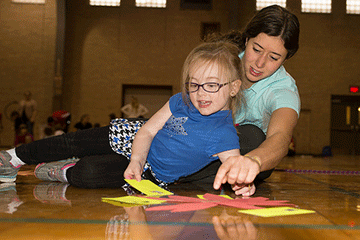
For more information, contact the Physical Education Department at 607-753-5577.  Suggest a feature story Suggest a feature story
Faculty/Staff ActivitiesAndrea DavalosAndrea Davalos, Biological Sciences Department, is part of a team of collaborators assembled by Carrie Brown-Lima, director of Cornell University’s New York Invasive Species Research Institute, that works independently on different aspects of swallow-wort ecology and control. Their work, keeping with the New York Invasive Species Research Institute’s mission to connect scientific researchers with on-the-ground managers to address key New York state invasive species issues, is detailed in a July 9 Cornell Chronicle article titled “Moth provides hope against invasive swallow-wort.” Pale and black swallow-wort are rapidly invading fields and forests across the Northeast. The team, which just received a grant from the New York Department of Transportation, will release swallow-wort biocontrol moths later this summer. Also this summer, two SUNY Cortland students are working with Davalos on the project: Jeremy Collings, who received a Summer Research Fellowship and a grant from New York State Flora Association to pursue a parallel question regarding swallow-wort management in New York State Parks; and Emily Ammons, who started this summer. Both students are mostly involved with Davalos’ project but have assisted with the biocontrol project and will continue to be involved throughout the year. Rhiannon MatonRhiannon Maton, Foundations and Social Advocacy Department, had her article, “From neoliberalism to structural racism: Problem framing in a teacher activist organization,” published in Curriculum Inquiry journal. Mechthild NagelMechthild Nagel, Philosophy and Africana Studies departments and Center for Gender and Intercultural Studies, gave an invited talk titled “Reconsidering the US’ Prison Dilemma: A Critique of the Affective Economy of Mass Incarceration” at a special seminar for the Microeconomic Seminar Series held June 11 at Pompeu Fabra University, Barcelona. Sebastian PurcellSebastian Purcell, Philosophy Department, had his article, “Life on the Slippery Earth,” published in Aeon magazine’s July 4 issue. Purcell’s article discusses how the Aztec moral philosophy has profound differences from the Greek tradition, not least its acceptance that nobody is perfect. Larissa TrueLarissa True, Kinesiology Department, was the organizer of a symposium held June 21 to 23 at the North American Society for Psychology of Sport and Physical Activity’s national conference in Denver, Colo. In addition to organizing the symposium, True presented a recent study titled “Tracking of Physical Fitness Components from Childhood to Adolescence: A Longitudinal Study.”  Submit your faculty/staff activity Submit your faculty/staff activity
|
The Bulletin is produced by the Communications Office at SUNY Cortland and is published every other Tuesday during the academic year. Read more about The Bulletin. To submit items, email your information to [email protected]
© 2026 SUNY Cortland. all rights reserved.